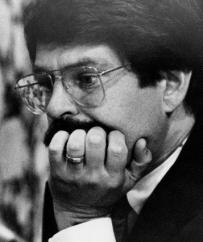Zev Yaroslavsky, then 5th District Councilman, presents an op-ed on the future of Los Angeles' building capacity. He argues that Los Angeles has been completely "built out: and as such city planners have to focus on current planning revisions to provide solutions.

Zev Yaroslavsky
"For too long, Los Angeles has had a boom-town philosophy. When we ran out of room to build, there was always some place further out to go."—Zev Yaroslavsky
As we look ahead to the 1990's, the Fifth Councilmanic District faces a host of issues and problems: What can we do to make our neighborhoods safer places in which to live? How will commuters get to and from work when the freeways and main highways which serve the area are often gridlocked? What are the limits of commercial development?
One of the most important areas we must focus on is uncontrolled growth and its relation to transportation; a clear relationship has been established between the construction of new buildings and the amount of traffic generated by the uses of that building.
I helped create the Century City Specific Plan, the first planning document in the City to limit new buildings based on the number of trips generated by the use of those buildings. Since that time, other planning documents have utilized this technique, helping to link transportation needs with development concerns.
By limiting development, we can reduce the number of cars gridlocking our streets and freeways. Prop. U, passed by almost 70 percent of the voters in 1986, reduced the density of most commercial buildings by one-half. Through this slash in density, potential traffic growth in the future will be averted.
For many years now, I have down-zoned the allowable height of commercial buildings on most major streets in my district to three stories. Along Melrose Ave., the limit is two stories. These actions have fostered development that is compatible with the area.
We also need a combination of innovative strategies to meet the complex transportation challenges of the coming decade. For example, we need to encourage commuters to rideshare, by carpooling or by taking the bus. Cyclists who live close enough to work to bicycle should be encouraged to do so through provision of bicycle facilities such as showers, lockers and secure locks. Another strategy is to encourage companies to institute flex-time scheduling, which permits workers to arrive and leave at more flexible hours.
One way to maximize our transportation resources is to remove trucks from the freeways during rush hours. I've successfully removed fifteen percent of all trucks from the Ventura freeway construction project area through a voluntary truck avoidance program which asks truck drivers to avoid using the freeways during the morning and afternoon rush hours.
According to a Southern California Association of Governments study, on any given workday, one major accident involving a truck can tie up traffic for from two to four hours, reducing the available capacity of the freeway by as much as 76 percent. Nearly one-third of major truck accidents occur on or near the peak commuting hours.
If we can get the Federal government to agree with us, and amend trucking laws to accommodate a total ban, imagine the bonanza of benefits we could reap: air quality would be improved, freeways wouldn't be clogged because of time-consuming truck accidents, and more cars would be able to utilize the available lane space.
In the future, I see a need for long-term strategic planning which examines land-use patterns in a comprehensive manner, taking into account such variables as traffic circulation, open-space and the impact of a project on the City's infrastructure, such as the sewers and water. For too long, Los Angeles has had a boom-town philosophy. When we ran out of room to build, there was always some place further out to go.
We've run out of room; we have no place to hide. We must face the future of Los Angeles squarely, and rise to the challenges it presents
- Log in to post comments



